Teaching Through Trade Books
Colorful Creations
Science and Children—October 2019 (Volume 57, Issue 3)
By Christine Anne Royce
This column includes activities inspired by children’s literature.
Helping students understand the engineering design process requires that they not only understand the goal of engineering, which is to “solve problems that arise from a specific human need or desire” (NRC 2012, p. 27), but to also learn how science is used within this process. Therefore, assisting students to connect both science concepts and the iterative process within engineering design is necessary. The books selected this month focus on design and redesign over time based on the desired outcome for the product. Younger students focus on how different parts within a system perform a particular function to meet the desired goal as they investigate the evolution of the balloons used in the Macy’s Day Parade, whereas older students focus on how physical and chemical changes were part of making Crayola Crayons.
This Month’s Trade Books
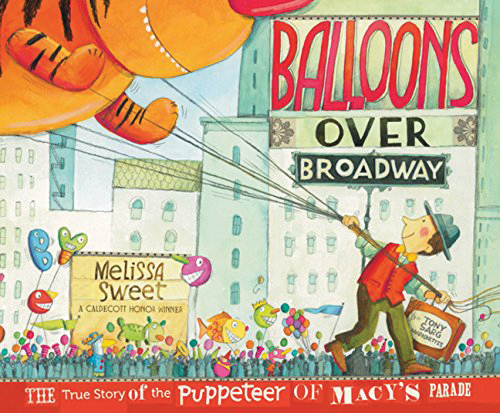
Balloons Over Broadway
By Melissa Sweet
ISBN: 978-0-547-19945-0
Houghton Mifflin Books for Children
40 pages
Grades K–4
Synopsis
This award-winning book tells the true story of a puppeteer turned balloon master who invented the giant balloons that are part of the annual Macy’s Thanksgiving Day Parade in New York City. Initially referred to as “upside down puppets,” Tony Sarg took on the challenge to make the parade bigger and better in 1928, and his designs have affected the parade experience ever since.
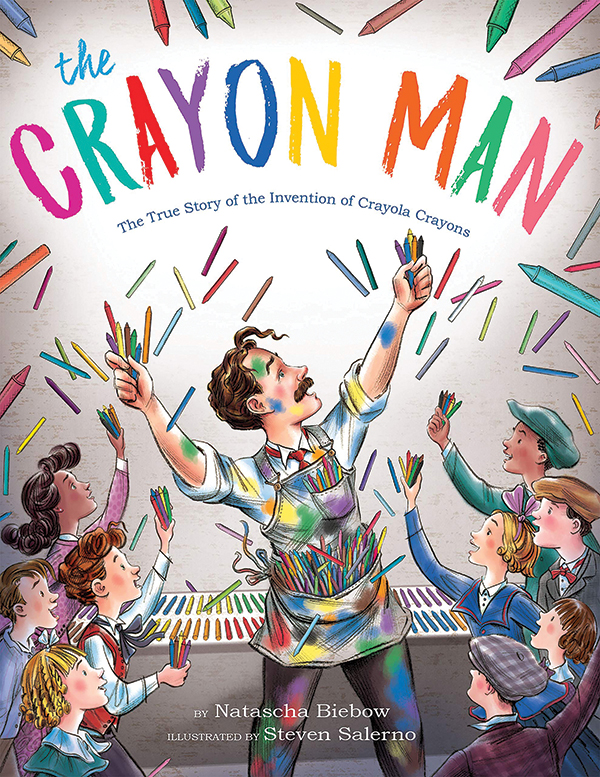
The Crayon Man: The True Story of the Invention of Crayola Crayons
By Natascha Biebow
Illustrated by Steven Salerno
ISBN: 978-1-328-86684-4
Houghton Mifflin Harcourt
48 pages
Grades 1–5
Synopsis
Colorful crayons were invented by Edwin Binney. His reason for doing so was that he loved the different colors found in nature and wanted to share those with children. This book discusses everything from how the name Crayola was selected to the different minerals that are used to create the colors.
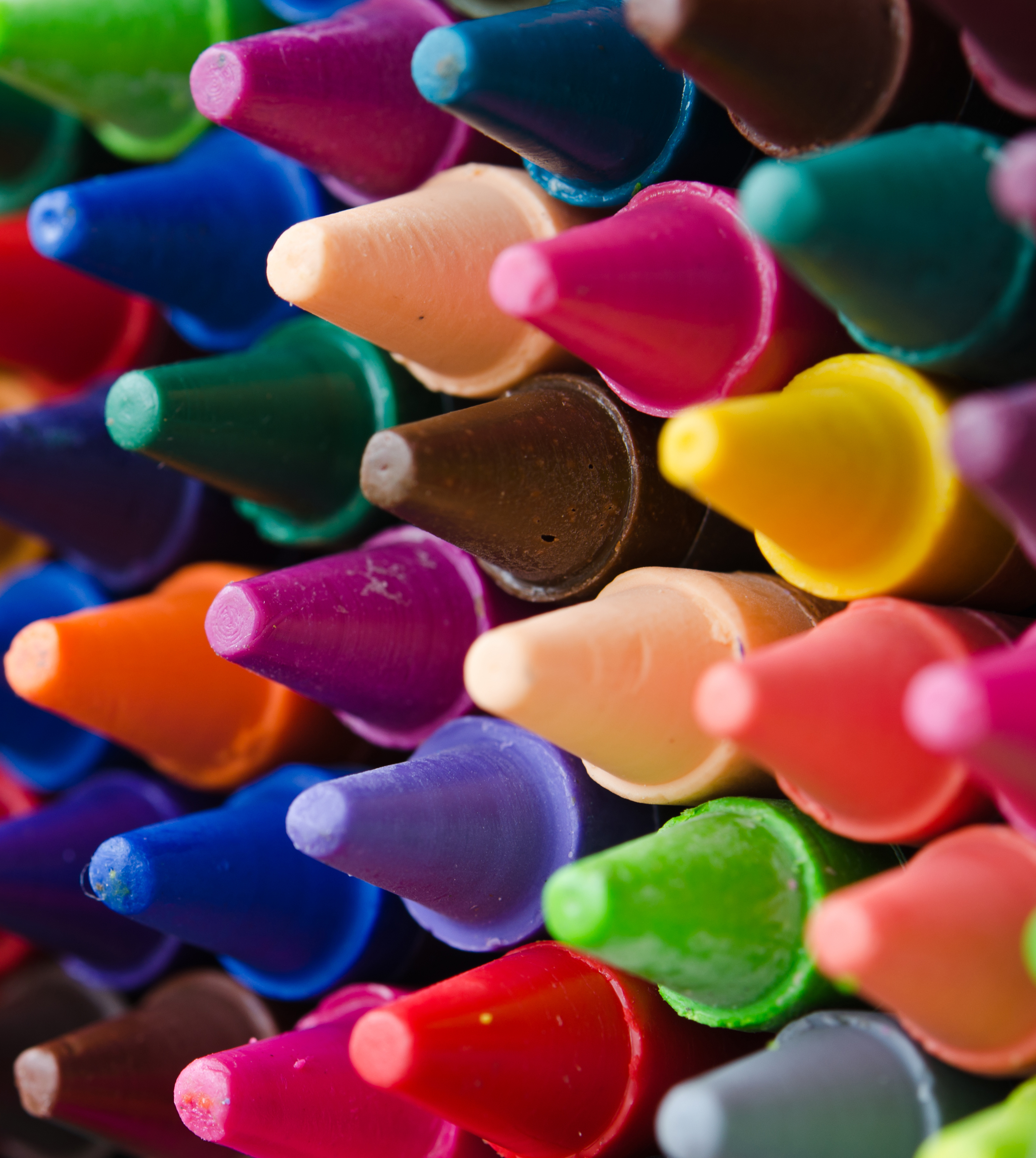
Grades K-2: Puppet Parts
Purpose
Students will describe how two different types of simple machines are used to make objects move and examine how they make puppets come to life. Students will create, test, and redesign their own series of interactions to solve a problem.
Engage
Show the students a balloon that has been inflated by air and a balloon that has been inflated with helium and ask them to make observations about the balloons. What do they notice that is the same? What is different? After making observations, ask students to consider how each balloon could be used as a puppet. Allow students to brainstorm and be creative on the second question. Once students have had a chance to think about how a balloon could be used as a puppet, introduce the cover of Balloons Over Broadway to the students and ask them to make observations about the balloons on the cover, which have different colors and shapes, and also note that strings are used to hold them so they don’t float away. Which of the balloons shared with them at the beginning of the lesson is most like the ones on the cover? Read the story to the students and discuss the following ideas: pp. 3–4: Ask the students to look at the contraption or invention that Tony designed to feed the chickens and describe what happens when Tony would pull on the rope. Have the students consider why he might have built it and why people build things in general to connect to the goal of engineering. pp. 5–10: What is a marionette? What types of material did Tony use to make these puppets? How were puppets used in the store windows and the Macy’s Day Parade to tell stories? pp. 11–16: What was the problem that Tony was asked to solve for the parade? How did Tony use his puppets and the information he learned from making puppets to solve the problem? What did he fill these rubber characters with? pp. 17–22: The second problem that Tony needed to solve was to make the puppets so that they could be high in the air to allow others to see them. How did he have to change the design of a puppet to do this? What were some of the changes that he made to create his large rubber puppets? p. 30: What were some of the things that Tony Sarg had to figure out as he changed his puppet design over time?
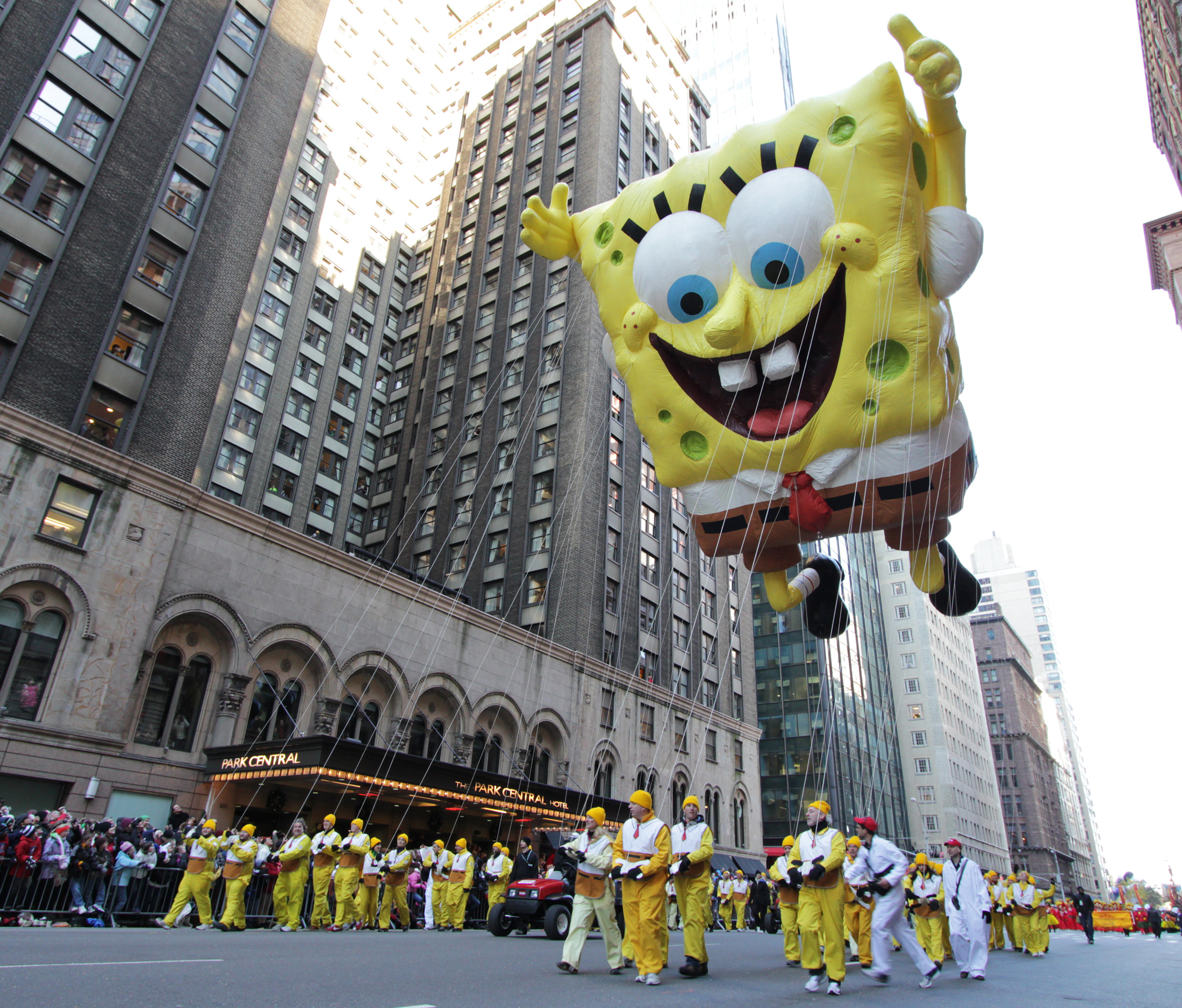
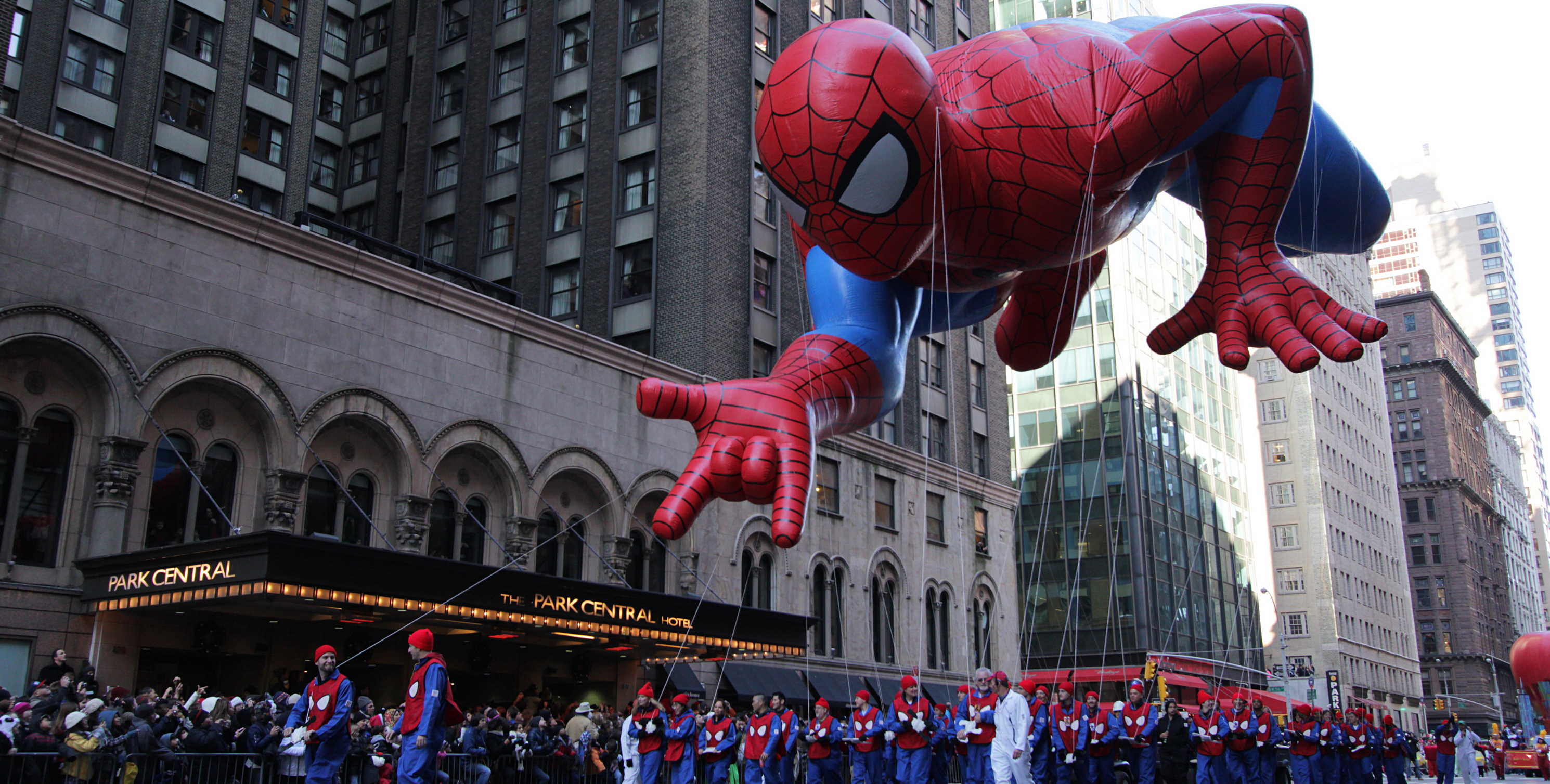
Explore
Once students have had an opportunity to discuss how the marionettes and later the parade balloons were designed and the fact that they are made of parts that bring them to life, pose the idea that one movement impacts how the balloon moves. Share with them several different pulley systems and levers for them to explore how they help objects move. The tasks that will help the students explore movement with these two machines are below. Within groups of three to four, ask students to explore these machines and to complete their observations on the “Machines Help Move Parts Student Data Sheet” (see NSTA Connection).
Task #1 Levers: Using simple levers, ask students to move different objects up and down with the lever. Have students follow the directions on the student sheet which asks them to raise different objects of different masses. At the conclusion of this task, ask students to consider real-life examples of where levers are used.
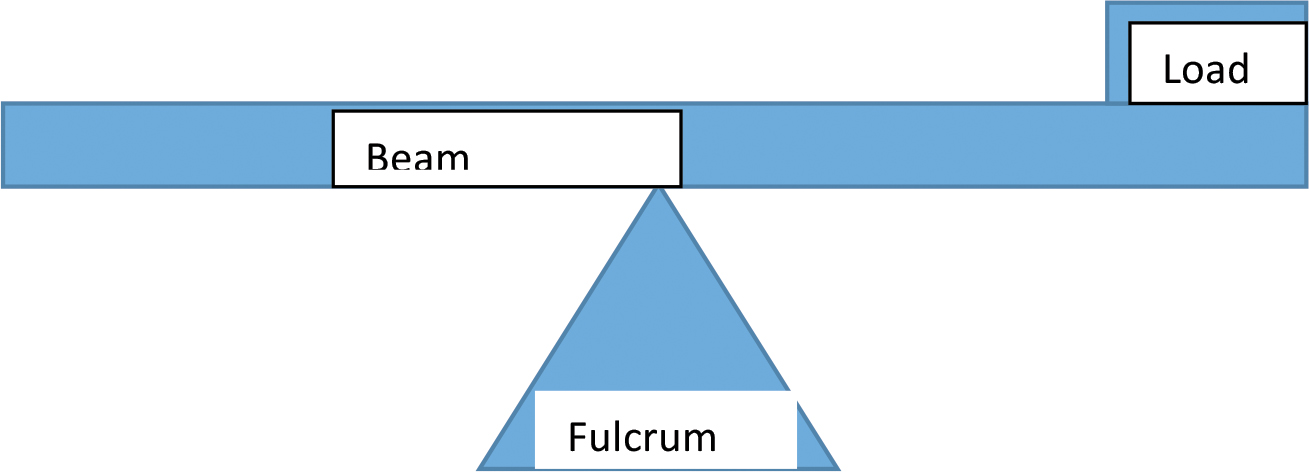
Task #2 Pulleys: Using a single pulley system, have students investigate how pulleys work and what the purpose of a pulley is. Students should sketch the pulley on their student sheet and complete the tasks that ask them to explore how a pulley helps move objects. Discuss where in the book they see representations of a pulley being used. Questions to help facilitate this discussion include: In the book, Tony Sarg discusses how he created marionettes; where in the pictures of the marionettes can you see a pulley used? How do you think pulleys help move the different parts of the puppets?
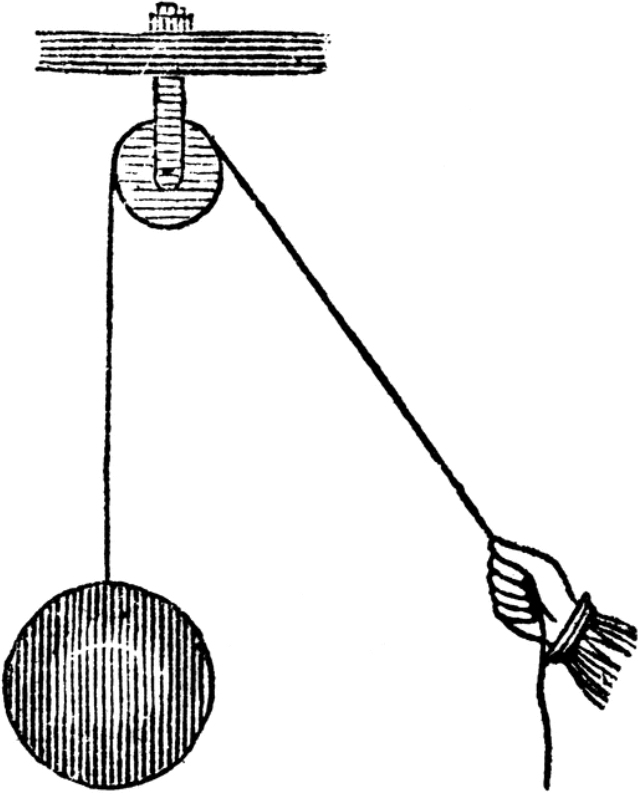
Once the students have had a chance to explore both levers and pulleys, ask students to discuss how machines are composed of different parts, each of which helps perform a particular action. Returning to the book, ask students to closely examine the illustrations and point out where different parts of the puppets are moved by individual actions from either machines or the puppeteer.
Explain
Although students interacted with the parts of simple machines, they may or may not have focused on the names of different parts. Bring the students back together and, using samples of the simple machines, ask them to describe what they learned in the stations. Help introduce the terminology to the students and ask them to use it as they describe what they learned in the stations.
If a pulley system is not available, Figure 1 can be used as an easy classroom pulley system. Guiding questions include: When you consider a lever, why would it be important for people to use levers to move larger objects? Does it matter where you place the fulcrum or the balance point for the lever? If I wanted to move a very heavy object, would I put the fulcrum under the lever closer to the object? Or farther away from it? Why do pulley systems help move objects? As you pull down on a rope in a pulley system, what direction does the object move? If I wanted to make an object move up and down, describe how you would use the pulley to do so?
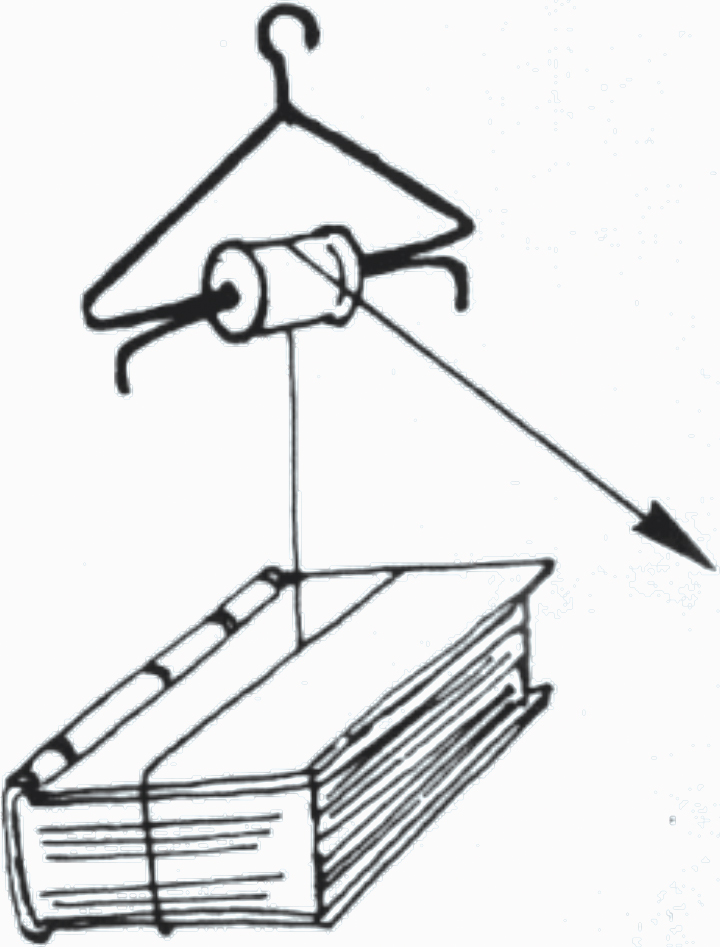
Elaborate
Return to page 2 in Balloons Over Broadway and read the quote to the students that states, “Every Little Movement has a Meaning of its Own” and ask the students to think about how things move and what it might mean when it is applied to the different balloons or puppets that Tony Sarg used. Then ask them to look at the invention that Tony used to feed the chickens again and consider what each movement did in that design. What happened when he pulled the rope? What type of simple machine was used to help move the door when the rope was pulled? What occurred after the door was opened? What one thing did he have to make sure he did the night before to make sure the contraption worked?
Tony was creative as a young child. Ask student groups to consider a task that they would like to make easier or simpler to accomplish by using a series of reactions to accomplish the task. It might be “empty the trash can,” “close the front gate to the yard,” “pick up socks,” or another task around the house. Allow students to brainstorm within their groups and make a list of tasks that might be made easier using simple machines. Have them keep this list on their “Making Life Easier Student Data Sheet” (see NSTA Connection). Following the brainstorming, ask students to settle on one particular task and design a contraption similar to what Tony did to the chickens. Individually, they each need to draw their design in the space provided on their data sheet. Then discuss each option with their classmates to include what they designed and how it works. In the groups, ask students to develop a single design based on the recommendations and parts from each different design and redraw their answer. If possible based on the problem that the students chose to solve, allow them to try and build their design and test it. Present their design to the class by describing what it does, how it does it, and what types of simple machines are used to complete the task.
Evaluate
Evaluation happens in a variety of locations starting with students responding with their initial thoughts about how things move and recording their observations through investigations with simple machines as they engage in the station tasks. Once students have had a chance to explore, they return to the larger class and discuss how simple machines help make work easier and how simple machines can be modified. Students apply their understanding of how separate actions within a series of actions can use simple machines and how that series of actions can solve a problem.
Connecting to the Next Generation Science Standards (NGSS Lead States 2013)
K–2: Puppet Parts
- The chart below makes one set of connections between the instruction outlined in this article and the <i>NGSS</i>. Other valid connections are likely; however, space restrictions prevent us from listing all possibilities.
- The materials, lessons, and activities outlined in the article are just one step toward reaching the performance expectation listed below.
Standard
K-2 ETS ENGINEERING DESIGN
https://www.nextgenscience.org/dci-arrangement/k-2-ets1-engineering-design
Performance Expectations
K-2 ETS 1-3. Analyze data from tests of two objects designed to solve the same problem to compare the strengths and weaknesses of how each performs.
2-PS1-3. Make observations to construct evidence based account of how an object made of a small set of pieces can be disassembled into a new object.
Grades 3-5: Creating Crayons
Purpose
Students describe the experimental process that lead to the Crayola crayon. Students investigate physical changes with how pigments are separated and crayons react when heated.
Engage
Show students a box of Crayola crayons and share the different color names with students. Ask them why they think the name of the color is an accurate one for the color or why it may not be. Explain to the students that at one point in time, there were only eight colors, but today we can have many options. Share the cover of the book, The Crayon Man, with students and explain that this is a true story of how Crayola crayons were invented. Ask students to listen to the story and focus on where science, engineering, and creativity were used during the process of inventing crayons. Ask them to jot down their thoughts about these areas on their “Creating Crayons Student Data Sheet” (see NSTA Connection). Questions to focus students as you read the story include: pp. 3–4: What was the product that the man’s company made? How was it used? pp. 5–6: In the photo with Edwin Binney and C. Harold Smith, the company they owned was called “Chemical Works.” Why do you think chemistry was important to what they produced using black soot and might be important to producing crayons? pp. 9–12: What were some of the reasons that people wanted Binney to focus on producing crayons for children? What were some of the problems with the three types of writing instruments they already produced? pp. 13–14: Carefully look at the photo and the different materials, objects, and notes on the pencils. Why do you think there were notes on the pencils? How could this help Binney keep track of his research? pp. 15–20: How did the people who worked at the factory make color to add to the crayon with no color? Why do you think they used these products? What did they have to do several times to come to a final mixture? What did they find out about different pigments that they added? pp. 21–22: What were some of the processes and concerns that Binney and the scientists needed to consider as they made the crayons? pp. 27–28: What other improvement on a product happened at about the same time that allowed children to draw pictures to color more than in prior years? pp. 35–36: Why do you think it is important to have a process that is followed every time crayons are made?
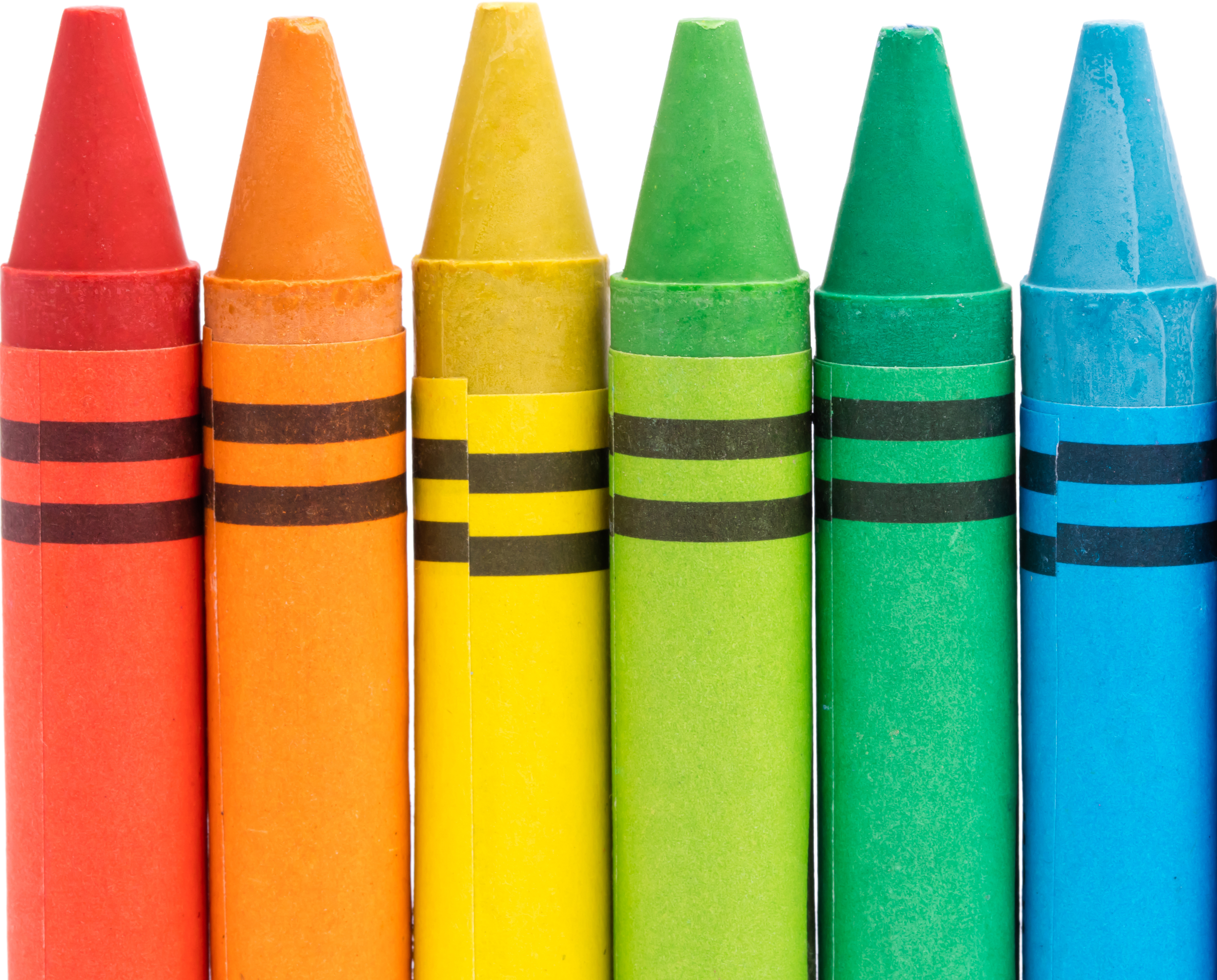
Explore
When Binney was beginning to explore the idea of colors, he noticed that the products that his company made were the following: a slate pencil, a wax crayon in black, and chalk that was white. Allow students to use these three items to try and draw simple shapes in the appropriate place on their data sheet. Ask them to make observations about how they appeared. Do they arrive at the same conclusions that were noted in the book? Next, introduce the word pigment, which is mentioned in the book. Pigments are materials (in this case, minerals ground into powders) that change the color of something as it interacts with light. Set up two stations. The first will allow students to explore pigments in marker inks and the second will allow students to consider how different-colored crayons react to the same temperature.
Station #1: Chromatography: Within the first station, students will use chromatography to separate inks in markers into the different-colored pigments. Students will need coffee filters, craft sticks or straws, tape, a plastic container that has high sides and can hold water (Ziploc serving containers that are approximately 15 cm [6 in.] high would work), and multiple water-based markers in the same color. Have students cut strips of the coffee filter that are about 3 cm (1 in.) wide and 15 to 18 cm (6 to 7 in.) long. Have them tape the top edge of the strip to the straw of the popsicle stick so that the strip hangs down and is long enough to almost touch the bottom of the container if the straw is laid across the top of the opening. After ensuring that the measurements work, students need to draw a straight line across the width of the strip that is about 3 cm (1 in.) from the bottom of the filter strip with one marker. Repeat this process with each marker that will be tested. Place about 3 cm (1 in.) of water in the bottom of the plastic container so that the ends of the filter strips are in the water but the water does not hit the maker line. Have students make observations about what happens to the ink as the water is drawn up the filter strip and record them on the sheet.
Station #2: Melting Crayons: The first part is to place a sheet of wax paper on a cookie sheet with two to three crayons of each of the following colors in separate piles: black, yellow, and red. Place the sheet in an oven that is set at 93°C (200°F). Ask students to make observations about the crayons after 5 minutes, 10 minutes, and 15 minutes and record them on their student data sheet. If you do not have access to an oven, two other options would be to place the tray with crayons in the sun outside and check at 10, 20, and 30 minutes. A second option is for the teacher to utilize a hair dryer with the crayons. What do they notice about the thickness of each color? The second activity asks students to take old crayons and break them into 3 to 5 cm (1 to 2 in.) pieces and remove the labels. Using a silicone mini muffin tray, ask students to place broken pieces of various colors in each muffin cup. Put them in the oven at 93°C (200°F) for 15 minutes and allow students to make observations. (Safety note: Teachers should ensure that they are the ones who remove objects from the oven and that students recognize that the melted crayons and trays are hot.) Return the tray to the oven for another 15 minutes or until the crayons have liquefied. Safety note: Allow the melted wax to cool. Record observations on the student data sheet while the wax is melted and after it has cooled.
Connecting to the Next Generation Science Standards (NGSS Lead States 2013)
3–5 Creating Crayons
- The chart below makes one set of connections between the instruction outlined in this article and the <i>NGSS</i>. Other valid connections are likely; however, space restrictions prevent us from listing all possibilities.
- The materials, lessons, and activities outlined in the article are just one step toward reaching the performance expectations listed below.
Standard
3-5 ETS ENGINEERING DESIGN
https://www.nextgenscience.org/dci-arrangement/3-5-ets1-engineering-design
Performance Expectations
3-5-ETS 1-3. Plan and carry out fair tests in which variables are controlled and failure points are considered to identify aspects of a model or prototype that can be improved.
5-PS1-4. Conduct an investigation to determine whether the mixing of two or more substances results in new substances.
Explain
Once students have had the chance to make observations about different types of writing instruments, separate ink colors, and observe what happens to different colors as crayons are heated, ask them to discuss the following points.
- What did you notice about the different grey, white, and black instruments that were used to draw shapes? Go back and observe these lines with a magnifying lens. Describe what you notice about the different types of materials used to make marks. Why do you think this happens? What information from the book helps you understand why this happens?
- In the chromatography activity, you used the same color from different brands of markers. Explain what you observed about the different markers as the ink was separated. Considering what you know about how the color of crayons are created, how do you think it is similar with the markers? Why might there be different colors in the separation of the inks?
- When paraffin and color pigments are mixed together and heated, a new product is created: the crayon. Do you think it is possible to separate these two things again? If you can’t separate the two substances, would that be a physical or chemical change? Now consider the melting of the crayons. Was a new substance created or did the substance stay the same and simply melt together?
Have students return to their student data sheet and answer the questions about the types of changes that have occurred.
Elaborate
Binney was an inventor but was also a business man with a company. Why do you think the skill of listening was important to Edwin Binney? In the story, it describes how names of several colors were arrived at by listening to children and also collecting information. Part of being a business inventor requires not only trial and error in the design process but also collecting information. Students will be asked to take on the role of crayon color creator in this next activity. In student teams, ask them to do the following: Select one single color from nature similar to what Binney did as he looked around nature. This could be blues, greens, reds, etc. Using the color selected, fill in the color on the appropriate box on the “Selecting Color Student Data Sheet” (see NSTA Connection). Develop three different names for this “new” color like the ones mentioned in the book. Explain in the space provided, why each name was selected.
Once this first process has been done, have the students collect data on their new colors by asking people to look at the new color and names and identify their choice for their favorite name. Record each individual’s personal selection on a tally sheet. Once students have collected between 15 and 20 responses, ask them to create a graph that represents their data and present it to the rest of the class.
Evaluate
This activity has students considering several factors, including how crayons were created and physical versus chemical changes, examining pigments in ink and comparing them to pigments in crayons, and finally collecting data similar to how Binney would about the color name choices. Throughout students are making observations, connecting their understandings back to the text material, and explaining their understanding of the content and presenting their findings from research.
Connecting to the Common Core State Standards (NGAC and CSSO 2010)
This section provides the Common Core for English Language Arts and/or Mathematics standards addressed in this column to allow for cross-curricular planning and integration. The Standards state that students should be able to do the following at grade level.
English/Language Arts
Reading Standards for Informational Texts K–5— Key Ideas and Details
- Grade 4: “Refer to details and examples in a text when explaining what the text says explicitly and when drawing inferences from the text.”
Writing Standards K–5 Research to Build and Present Knowledge
- Grade K: “With guidance and support from adults, recall information from experiences or gather information from provided sources to answer a question.”
- Grade 4: “Recall relevant information from experiences or gather relevant information from print and digital sources; take notes and categorize information, and provide a list of sources.”
Writing Standards K–5— Text Types and Purposes
- Grade K: “Use a combination of drawing, dictating, and writing to compose informative/explanatory texts in which they name what they are writing about and supply some information about the topic.”
- Grade 2: “Write informative/explanatory texts in which they introduce a topic, use facts and definitions to develop points, and provide a concluding statement or section.
- Grade 4: “Write informative/explanatory texts to examine a topic and convey ideas and information clearly.”
Speaking and Listening Standards K–5— Presentation of Knowledge and Ideas
- Grade 1: “Add drawings or other visual displays to descriptions when appropriate to clarify ideas, thoughts, and feelings.”
Vocabulary Acquisition and Use is one of the standards for language. This particular standard is across grade levels: “Determine or clarify the meaning of unknown and multiple-meaning words and phrases based on grade [appropriate] reading and content.” Furthermore, the Common Core for ELA provide a standard related to the Range of Text Types for K–5 where it indicates that students in K–5 should apply the Reading standards to a wide range of texts to include informational science books.


